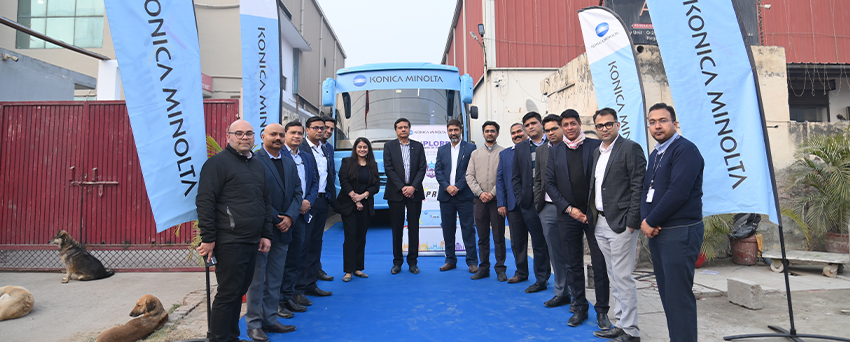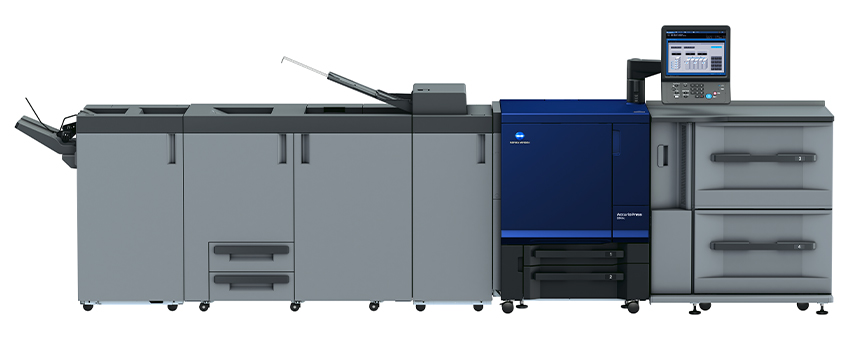In the future, more and more manual work, such as checking print output systems, will be streamlined by AI. Overall, AI makes for safer and more efficient work. And there is also great potential for savings in the area of procurement for professional and production print materials. What are the future scenarios and what does AI already do for print shops today?
AI, Machine Learning and Deep Learning: A Defining of the Terms:
Artificial intelligence is the result of deploying machine learning and deep learning techniques. The sense of ‘intelligence’ comes from the fact that machines learn and adapt without human intervention. Whilst the principles are not new, access to large data sets and lowering costs of high-performance computing have enabled a new science to emerge. The two main contributors to artificial intelligence are:
Machine learning uses algorithms to ‘learn’ from images or other data. Machine learning usually involves human intervention, manual tagging of sample images to classify subsequent images at higher volume. A human marks up images so that key features are recognised by a computer and then a model is built to predict the likelihood of an image match from a data feed. Examples of the use of machine learning include facial recognition or analysing the contents of a complex image scene. Machine learning is a rapid way to build a data model from a relatively small data set.
Deep Learning is a subset of machine learning. In essence, instead of a human intervention tagging data to recognise image, sound or text elements, deep learning builds the model of recognition automatically. This requires much larger data sets, and it takes much longer to build the models. ‘Neural networks’ are often deployed which are intended to mimic human methods of leaning and adapting to new data. Not only can deep learning recognise data elements such as images, it can also recognise tasks. This is why this technology becomes important to process-intensive operations. The tasks which are embedded in every day operations have potential for intelligent automation of both software systems and physical systems such as robot arms.
Konica Minolta uses all three elements across its portfolio with varying degrees of intelligence and sophistication, starting with basic intelligence for print operations.
How print businesses benefit from AI:
AI is currently being used to make the workplace and production environment safer and more reliable, and to make life easier for production staff.
For print shops, the use of AI optimises personnel costs through automation. In addition, AI allows resources to be better planned and sustainability goals to be better achieved. Printers will be able to control more tasks remotely, and 24-hour operation for better press utilisation, together with optimal planned maintenance.
The AI-supported print shop will not be completely automated. But the AI systems support the humans, facilitate scheduling, improve utilisation and help the production manager in efficient job planning and utilisation of stock materials.
This enables intelligent planning that deviates from the previous principle of ‘first in, first out’ and changes machines, substrates and sizes less often. But this does not mean that people will be replaced: employees will have a safer and better workplace where they will receive clear, intelligent instructions on how to proceed in their production shift in order to complete orders faster and in a more resource-efficient way. This will allow skilled people to focus on the print shop tasks where humans do best. For example, humans are best leveraged on the creative side, the customer journey satisfaction, the process optimisations like fine tuning, the creation of new business opportunities or proposed print products.
Intelligent solutions from Konica Minolta
- Intelligent algorithms that determine different document layouts and minimise print waste during the production print process. For direct mail and catalogues, personalised mailings can be automatically created with variable content that is determined by an individual customer profile. AI makes this process more efficient and less error prone.
- When it comes to job submission, intelligent software routes new jobs directly to presses that are currently available because it can monitor which presses are busy and which are not. Self-monitoring presses constantly monitor themselves with numerous sensors. Based on the data, algorithms can adjust in real time, for example in paper orientation and image quality. The outcome is the best possible print result without human intervention. Operational data about the press can be sent directly to Konica Minolta. Specialist staff will analyse press data with tools and algorithms and compare it to the expected performance. A technician can then identify and recommend software updates or adjustments. Predictive analytics identify service needs and initiate maintenance even before service interruption and downtime.
- Konica Minolta’s Intelligent Quality Care (IQ-501) saves time during printing with powerful and automated adjustments for image position, registration and absolute colour control, including hybrid colour measurement and real-time correction for print output. With Intelligent Quality Care, you can create versatile and new print products in no time at all.
- It is also possible to automatically detect and correct paper registration and correct problems in individual print jobs while printing is in progress without human intervention. This addition simplifies the printing process significantly.
Future scenarios of AI for Production Printing
The next area where artificial intelligence comes into play is in the assessing of the quality of the output of an object, particularly a surface or edge. If we look at cutting, for example, which takes place after printing, the accuracy of cuts can be assessed by camera technology connected to a quality inspection system. This is where AI can be applied and continuously learn, taking over some of the manual processes of people who can be applied to more profitable tasks.
Another future scenario is material handling with connected robots. For example, AI can calculate how long a print job will take and how much paper will be consumed in the process and arrange for reloading accordingly, bringing the correct supplies from a store to the side of the machine for manual handling. In-line paper loading by robots is under investigation – the main challenge being accurate alignment with the loading bay of large printers.
A third area is the use of an AI like ChatGPT to improve interaction and, for example, quickly retrieve and use the technical know-how that now lies in manuals and documentation. The AI technology that Konica Minolta can provide to its customers today is growing. Solutions range from hardware for automatic quality inspection and correction capabilities of the IQ-501 Intelligent Quality Care-solution to AI systems connected via the Internet of Things, such as industry-standard collaborative robot arms. Camera systems can also automatically analyse environments such as moisture or heat, and track health and safety aspects of the workplace – whether caused by people, machines or environmental issues.
Konica Minolta can also combine these types of IoT technologies to generate new and actionable insights for the printing industry and in the production printing environment. We are also working on integrating solutions for prepress, press and post press as an end-to-end solution. Our aim is to connect the dots to reduce manual touch points according to the principles of Industry 5.0.
- Safer workplaces
- More reliable production environment
- Smarter, automated decision-making by linking information from different sources
- Faster decision-making
- Minimisation of errors
- Cost-reducing, automated procurement
- Better resource and schedule planning
- More sustainable printing
- Lower personnel costs
- Higher press utilisation
Our customers can open a whole new chapter of inline capabilities in production printing and industrial printing with Konica Minolta, encompassing prepress, press and post press as a single system that works together harmoniously and can be controlled by automated decision-making processes such as AI- and ERP systems working together.



